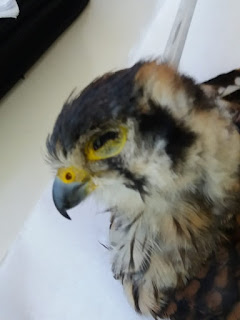Birding in Barbados in 2018 meant a year of mega-rarities, rarities, and birds aplenty. The mega-rarities included a first and a few seconds recorded for the island. We also tallied one of, if not the highest, year species count, recording overall more than 120 species, with Dr. John Webster recording the highest individual local count of 109 species according to bird recording website ebird. For the second year running, we saw a few pelagic birds represented on the checklist. Let us look at some of the year's highlights.
Mega-rare Birds
One new bird was added to the island’s checklist during 2018. That bird was a Bat Falcon (Falco rufigularis) which is a small South American raptor that specializes in preying on bats. The bird was first reported on by Grete Pasch at Sion Hill, St. James. This was believed to be the first confirmed record for the West Indies. We also had a few second record birds. The January record of a female Hooded Merganser (Lophodytes cucullatus) in Christ Church represented the first record since December 1996*. This was followed by a juvenile American Flamingo (Phoenicopterus ruber) at Chancery Lane in February, this was the 1st record since May 2004*. White-crowned Pigeon (Patagioenas leucocephala) was first recorded on the island in 2014 and made a big return in 2018 when multiple birds were spotted all over the island. Other
 |
| Dead American Kestrel |
Mega-rare birds that were reported on throughout the year was a Black Tern (Chlidonias niger) at Pile Bay, St. Michael, Broad-winged Hawk (Buteo platypterus) at Graeme Hall Swamp, Pacific Golden-Plover (Pluvialis fulva) in St. Philip, a second Eurasian Spoonbill (Platalea leucorodia) at Walkers, St. Andrew, the 3rd confirmed record for the island. The sighting of the House Sparrow (Passer domesticus) on the island, the first time in nearly two decades was surprising. It was made by a visiting team of experienced birders at Sunbury, St. Philip. The saddest of all our rare bird sightings for 2018 was the recovery of a dead American Kestrel (Falco sparverius) in Christ church. The bird was involved in an accident and did not survive. These sightings emphasized the type of year we had and it was made even better by the reports of pelagic bird sightings by a few visitors to the island.
Pelagic Birds
Visiting birder, Andy Keister, “lucked out” while on a fishing trip just off the west coast in March. He reported seeing pelagics such as Leach's Storm-Petrels (Oceanodroma leucorhoa), Pomarine Jaegers (Stercorarius pomarinus), Bridled Terns (Onychoprion anaethetus) and Brown Boobys (Sula leucogaster). Another visitor reported and shared photographs of two Masked Boobys (Sula dactylatra) he saw while sailing out of the island. I must agree with Andy when he suggested that more attention should be paid to sea watching and pelagic trips. It is an area that is ignored by local birders.
We had our customary run of rare birds, Gray Heron, Ruff, Purple Gallinule, Black-headed Gull, Bobolinks etc. yes we saw birds aplenty in 2018 we look forward to the coming year.
*The Birds of Barbados – P.A. Buckley, Edward Massiah, Maurice Hutt, Francine Buckley, Hazel Hutt




































